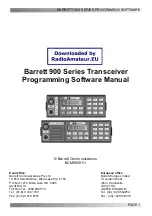
COE Communications Engineering Document
Author:
Keith Gilbertson
Rev:
A
Date:
3/08/02
Pag
e:
4
of
33
GE
TRANSPORTATION
SYSTEMS
GLOBAL SIGNALING DIVISION
Title:
12RII FCC TECHNICAL MANUAL
5.
12RII Radio Systems
The 12RII radio supports 3 major types of FM voice radio systems or applications. AAR Remote Control (RC), Locomotive
Clean Cab (LC) and Serial Remote (SR). All have similarities in basic radio operation. The major difference between the RC
and LC applications is the type of user interface. The RC uses the AAR standard interface for remote control radios. This
interface is defined in section 12-10 of the AAR C&S Manual. The LC radio has a built in control panel on the front of the
radio. Interfaces to the LC radio are defined in section 12-2 of the AAR C&S Manual. The SR radio system is identical to the
standard LC radio except that the front panel is installed in a remote mounted control head.
Note 1:
This device complies with Part 15 of the FCC Rules. Operation is subject to the condition that this device does not
cause harmful interference.
Note 2:
Changes or modifications to this device not expressly authorized by the manufacture could void the user’s authority to
operate the equipment.
Note 3:
This equipment has been tested and found to comply with the limits for a Class B digital device, pursuant to part 15 of
the FCC rules. These limits are designed to provide reasonable protection against harmful interference in a residential
installation. This equipment generates, uses, and can radiate radio frequency energy and, if not installed and used in
accordance with the instructions, may cause harmful interference to radio communications. However, there is no guarantee that
interference will not occur in a particular installation. If this equipment does cause harmful interference to radio or television
reception, which can be determined by turning the equipment off and on, the user is encouraged to try to correct the interference
by one or more of the following measures:
-
Reorient or relocate the receiving antenna.
-
Increase the separation between the equipment and the receiver.
-
Connect the equipment into an outlet on a circuit different from that to which the receiver is connected.
-
Consult the dealer or an experienced radio/TV technician for help.
Note 4:
FCC RF Radiation Exposure Statement
This equipment complies with FCC RF radiation exposure limits set forth for an uncontrolled environment. This equipment
should be installed and operated with a minimum distance of 20cm between the radiator and your body.
Note 5:
Professional installation of radio and antenna system is required to ensure proper operation and installation of this
equipment. To conform to FCC RF Radiation Exposure limits the installer must remain at least three meters away from the
transmitting antenna when the unit is transmitting. The antenna must be mounted on the top of the train engine as directed in the
installation guide.
5.1.
AAR Remote Radio System
5.1.1. General
Description
The 12RII-RC radio is compatible with the current 12R-RC radio in all its existing AAR Remote Applications. Refer to the
block diagram in the following section. In the AAR Remote application the primary interface for controls and audio signals is
with an external AAR compatible Control Head or Control Panel. Optionally an AAR handset can be connected to the rear of
the radio at J2. Antenna connection is provided through J1.
The 12RII-RC radio will mount onto the standard 12MT-1 AAR mounting adaptor. The radio will get locked into the 12MT-1
adaptor tray and they are installed as a unit onto a standard AAR Mounting Base such as the 1MB-1. The Mounting base
provides terminal blocks that allow the train wiring from the control panel and battery to be interfaced into a standard cable
supplied with the 1MB-1. This cable mates to J5 on the 12RII radio and provides power and control interface.





































